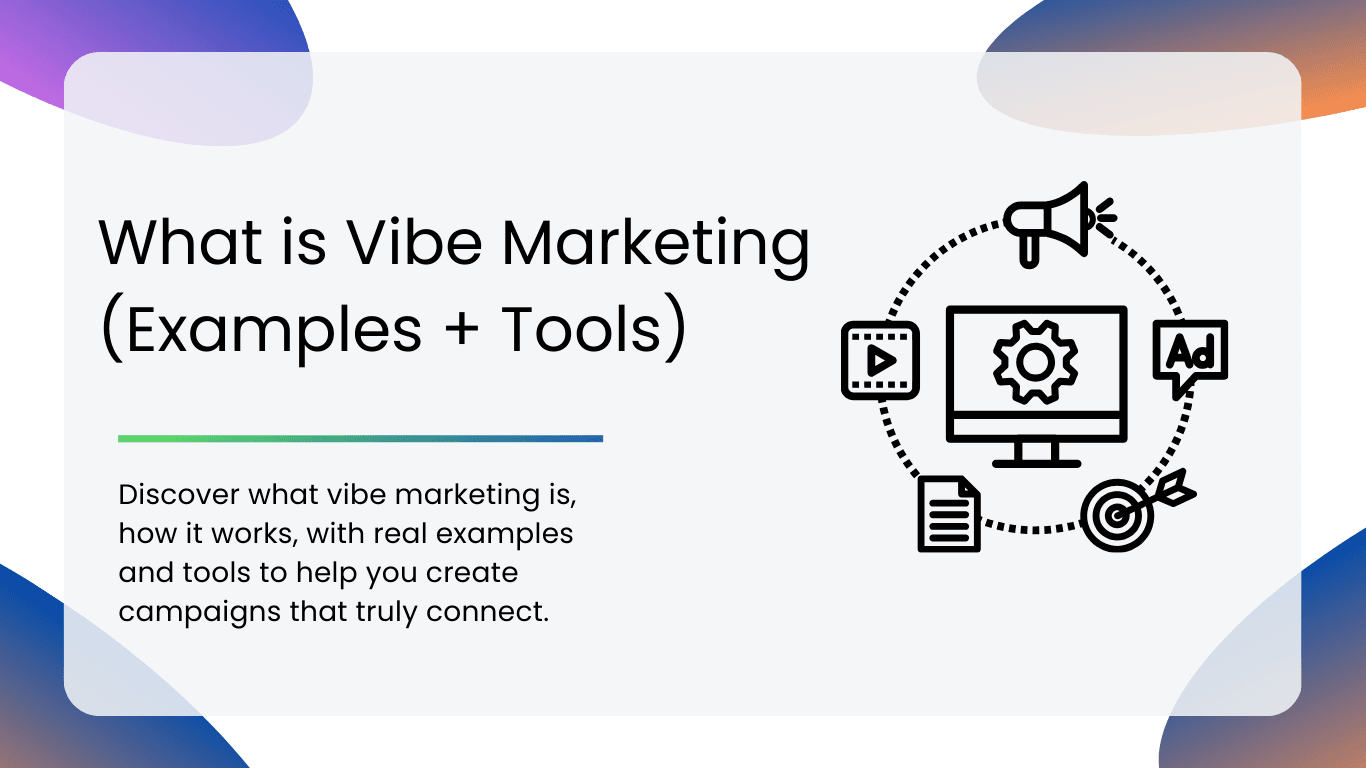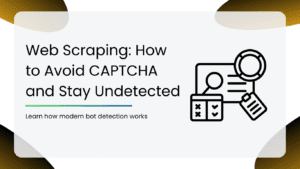Marketing has evolved, and vibe marketing is leading this change. It uses AI and automation to make creating, testing, and improving campaigns much faster than ever. What used to take weeks can now be done in just a few days or even hours.
However, vibe marketing is not only about speed. It’s about creating an experience and a feeling that truly connects with people. Instead of focusing only on selling products, it builds a mood that attracts and engages audiences, which makes them feel part of the brand.
In this blog, we will explore what exactly vibe marketing is, along with examples and tools to help you understand better.
What is Vibe Marketing?
Vibe marketing is a modern marketing method that combines AI-powered tools with automation in order to transform how campaigns are developed and managed. It replaces slow, manual processes with quick, data-driven cycles that help launch and optimize campaigns faster.
More importantly, vibe marketing is about setting the right mood that resonates emotionally with your audience. It creates content and experiences that feel genuine and relatable. This reflects the unique personality of your brand.
By using AI to test different versions of ads and personalize messages, marketers can quickly see what works best and make adjustments on the go. This allows smaller teams to work more efficiently while also building stronger and more authentic connections with their customers.
Why Vibe Marketing Matters in 2025
- Breaking Through the Noise: With so many ads competing for attention, vibe marketing helps brands stand out better by creating emotional connections that truly engage audiences.
- Speed and Agility: AI-powered tools enable quick testing and real-time adjustments. This allows brands to launch and optimize campaigns faster than ever.
- Keeping Up with Trends: Audience tastes change rapidly. Vibe marketing helps brands stay relevant by adapting their message and mood to what people connect with right now.
- Building Authentic Connections: Consumers want brands that feel genuine and relatable. Vibe marketing creates a personality and vibe that matches customer values and lifestyle as well.
- Doing More with Less: Small teams can now run effective and personalized campaigns at scale by leveraging automation, making marketing more efficient without losing creativity.
Real-World Examples of Vibe Marketing
1. Coca-Cola’s “Create Real Magic” Campaign
Coca-Cola took vibe marketing to a new level by inviting fans to participate in creating AI-generated art, which was inspired by its iconic branding. This campaign blended feelings of nostalgia with cutting-edge creativity, which allowed fans to feel part of the brand’s story.
By launching a digital gallery showcasing winning designs, Coca-Cola connected with its audience on an emotional level. This helped drive millions of social impressions and making the campaign feel more like a shared experience than a traditional ad.
2. Heinz’s “A.I. Ketchup” Campaign
Heinz used AI to generate images of ketchup, discovering that 90% looked strikingly like their famous bottles. They turned this insight into a clever and humorous campaign that played on their strong brand recognition. By leaning into this “Brand hacking” vibe, Heinz sparked a viral moment that did not only make people laugh but also gave the brand a 15% sales boost. This campaign showed how humor and authenticity could drive meaningful engagement.
3. Spotify’s AI DJ Feature
Spotify introduced an AI-powered DJ that curates personalized playlists with witty voice commentary customized to each listener’s habits. This smart use of AI creates a vibe that feels personal and interactive rather than generic. The feature taps into listeners’ emotions and preferences in real time, which resulted in longer session times and deeper user engagement. Spotify’s approach shows how vibe marketing can blend data and personality to build stronger user connections.
4. Nerd VPN Instagram Content
Nerd VPN uses AI tools to automatically generate a full content calendar for their Instagram, helping create 15 days of posts in minutes. The AI studies the brand’s existing style and tone, then crafts captions and visuals that stay true to their friendly and approachable vibe. This streamlined process not only saves time but also helps maintain consistent communication that builds trust with their audience. It’s a practical example of how vibe marketing combines efficiency with an authentic brand voice.
Traditional Marketing VS Vibe Marketing
| Aspect | Traditional Marketing | Vibe Marketing |
| Speed of Campaigns | Takes a week or months to plan and launch | Launches campaigns in days or even hours |
| Team Size | Requires large teams with specialized roles | Small teams leverage AI and automation |
| Budget | Often high budget due to manual processes | Lower cost thanks to AI-driven efficiency |
| Workflow | Manual, process-heavy, and time-consuming | Automated, data-driven, and highly agile |
| Content Focus | Broad messaging focused on product features | Creates mood, feeling, and emotional connection |
| Testing and Optimization | Limited real-time testing and slow feedback | Rapid testing with real-time data adjustments |
| Creativity | Human creativity with slower iterations | Human creativity amplified by AI efficiency |
| Consumer Connection | Transaction-focused communication | Builds authentic, relatable brand experiences |
Table of Contents
| 1. Gumloop |
| 2. n8n |
| 3. Digital First AI |
| 4. Flora |
| 5. Manus |
| 6. Relay |
| 7. Brandwatch |
| 8. Omneky |
| 9. Anyword |
| 10. Sprout Social |
| 11. Lindy |
| 12. Taskade |
Top AI Tools for Vibe Marketing
1. Gumloop
Gumloop is a no-code AI automation platform that makes marketing workflows simpler and faster. It helps marketers and small teams automate tasks such as content creation, data gathering, social media management, and SEO without needing to code. With its visual builder and built-in AI, Gumloop saves time and helps businesses scale their marketing efforts more efficiently.
Key Features
- Drag and Drop Workflow Builder: Lets you create complex automations using an easy visual interface.
- AI-Powered Content Generation: Creates blog posts, emails, and social media content automatically.
- Advanced Web Scraping: Pulls data even from websites that require login credentials.
- SEO and Competitor Analysis: Tools monitor keyword performance and rival campaigns as well.
- Social Media Monitoring and Sentiment Analysis: Keeps you updated on the brand reputation and activities of your competitors.
- Pre-Built Marketing Templates: Gives you ready-made workflows for common marketing tasks.
- The Browser Extension: Allows quick automation directly from your web browser.
Pros
- No coding is needed, which makes it accessible for marketers who do not have technical skills.
- Flexible enough to handle complex and multi-step marketing workflows.
- Saves a lot of time by automating repetitive marketing and administrative tasks.
- Scales well for small teams, freelancers, and agencies who have limited budgets.
- Affordable pricing, including a useful free tier to get started.
Cons
- There is a learning curve for users new to automation platforms.
- Advanced workflows might take some trial and error in order to set up perfectly.
- Power users might find the available templates limiting for highly customized needs.
Review
Gumloop is a user-friendly tool that helps marketers automate a wide range of daily tasks, from content creation to social media management. Its visual builder makes it very easy for non-technical teams to set up complex workflows. For small businesses or agencies looking to boost productivity without any hassle, Gumloop is a reliable choice.
2. n8n
N8n is an open-source workflow automation tool that is prized for its flexibility and power. It connects hundreds of apps and users to AI-driven workflows in order to automate complex marketing and lead generation tasks. Its open-source design means it is constantly improving with input from a strong community. This makes it ideal for marketers and developers who need custom, scalable solutions.
Key Features
- Visual Workflow Designer: Lets you build custom automations with a simple no-code interface.
- Extensive App Integrations: Connect over 500 services, including CRM, social media, analytics, and AI tools as well.
- AI-Driven Workflows: Powered by large language models, create smart automations that adapt on the fly.
- Customs Code Support: Let’s developers add JavaScript or Python to build advanced logic.
- Pre-Made Workflows Templates: Provides quick starts for marketing and sales automations.
- Secure Credential Management: Protects data with encryption and access that can be controlled.
- Flexible Deployment Options: Includes both cloud-hosted and self-hosted setups.
- Scalable Pricing: Charges based on workflow executions, so costs grow as you scale.
Pros
- Highly customizable, ideal for users who want deep control over their workflows.
- Cost-effective for scaling complex and large-volume marketing automation.
- Offers an extensive library of integrations with popular marketing and business tools as well.
- Supported by an active open-source community with regular updates and new features.
Cons
- It can be intimidating for marketers without any technical experience.
- Setup and configuration might require more time and effort than simpler tools.
- Best results often come when users have some coding knowledge, though this is optional.
Review
n8n offers impressive flexibility for building automated workflows between different apps and services. It’s especially helpful for those who want detailed control over their processes. While the learning curve is a bit steeper, once you get the hang of it, n8n can handle almost any marketing automation challenge that you might have.
3. Digital First AI
Digital-first AI is a powerful marketing platform that combines AI-driven content creation with visual workflow automation. It’s built for marketers who want to design, launch, and optimize campaigns quickly without depending on large teams. The platform brings together multiple AI models and marketing tools on one canvas. This offers flexibility and speed in executing data-driven strategies.
Key Features
- Visual Workflow Builders: Lets users drag and drop to design custom marketing processes.
- Content Generation Using Multiple AI Models: Produces high-quality copy for blogs, ads, emails, and social media.
- Data Room for Business Insights: Centralizes and analyzes your company data in order to make smarter marketing decisions.
- Strategy Canvases: Provides frameworks, like customer personas and value propositions, to guide campaigns.
- Real-Time Market Intelligence: Connects you with up-to-date competitor and trend data.
- Built-in Graphic Design Tools: Powered by AI, like DALL-E 3, for creating on-brand visuals.
- Workflow Automation: Links marketing steps to run campaigns smoothly from start to finish.
Pros
- Combines creative content generation with workflow automation for full-cycle marketing.
- Helps marketers work faster with data-backed insights and AI support.
- Supports small teams who are looking to scale without big agencies.
- Offers strong integrations within one platform to avoid juggling multiple tools.
Cons
- Advanced features can seem overwhelming without initial familiarization.
- Cost might be higher for smaller budgets compared to simpler standalone tools.
- Customization sometimes requires investment in learning the visual workflow system.
Review
Digital First AI stands out as both a planning partner and a creative assistant for marketing teams. It helps organize campaigns, provides strategic frameworks, and generates content ideas, all in one place. Teams who are looking for guided, step-by-step support in their marketing efforts will find this tool especially helpful.
4. Flora
Flora is an AI-powered creative canvas that is designed to streamline marketing content creation by integrating text, image, and video generation all in one workspace. It focuses on collaboration, rapid ideation, and iteration, making it perfect for teams that are aiming to develop a cohesive vibe for marketing campaigns that capture a brand’s unique voice and style.
Key features
- All-in-One AI Canvas: Combines text, images, and video creation effortlessly.
- Real-time Team Collaboration: Lets multiple users work together on campaigns instantly.
- Pre-Built Workflows: Offers pre-built workflows for Social media content.
- Rapid Ideation and Iteration Tools: Support quick generation and tweaking of creative assets.
- Access to Curated AI Models: Makes sure that high-quality content is generated across different media.
- Community Hub: Has a community hub for sharing marketing workflows and best practices.
Pros
- Combines different content types in a single easy-to-use platform.
- Designed for teamwork, enabling both smooth collaboration and feedback.
- Speeds up content creation without sacrificing creativity or brand consistency.
- Pre-built workflows help teams launch platform-specific social campaigns fast.
Cons
- Focused mainly on content creation, so it might need to be paired with other tools for full automation.
- Some features require learning to navigate efficiently, especially for new users.
- Limited customization for highly technical marketing automation compared to other platforms.
Review
Flora is a creative workspace designed for teamwork. Its AI features help you quickly produce text, images, and even videos, with everything happening in real time. It works especially well for marketing teams who want easy collaboration and inspiration in one place.
5. Manus
Manus is an AI-powered marketing automation platform that is designed to take over routine marketing tasks and research, allowing marketers to focus on strategy and creativity. It combines deep data analysis with content generation and project management. This makes it ideal for teams that want to automate complex workflows and improve marketing performance.
Key Features
- Task Automation for Marketing Workflows: Handles things like competitor research, content planning, and campaign execution.
- In-Depth Market Analysis: Generates detailed reports and actionable insights from complex data.
- Custom Marketing Outputs: Produces SEO-friendly blogs, interactive content, and storytelling that are tailored to your brand.
- Real-Time Data Visualization: Turns marketing metrics into clear, actionable recommendations.
- Multi-Project Management: Allows running and monitoring several marketing campaigns simultaneously.
- Credit-Based Pricing Model: Offers flexibility depending on marketing needs and usage.
Pros
- Automates complex and time-consuming marketing tasks effectively.
- Combines research, content creation, and data visualization in one tool.
- Suits teams aiming to boost productivity and scale campaigns rapidly.
- Helps maintain brand consistency through customizable outputs.
- Flexible pricing makes it accessible for different team sizes and budgets.
Cons
- Might require some time to adapt and set up for the best results.
- Advanced features could be overwhelming for smaller or less technical teams.
- Dependent on AI quality for creative and analytical outputs, requiring human review.
Review
Manus brings AI-driven automation to your marketing research and content workflows. It’s set up to streamline tasks like competitive analysis, campaign planning, and reporting, making life easier for marketers who juggle multiple projects. With Manus, focusing on bigger strategy and creative work gets a lot simpler.
6. Relay
Relay is an AI-powered platform that creates custom marketing AI agents to automate workflows while also keeping marketers in control. It connects with many popular apps and simplifies the complex marketing operations by letting AI handle all routine tasks like content summarization, data extraction, and message translation.
Key Features
- AI-powered Marketing Tasks: Automate content generation, translation, summarization, and data extraction.
- Flexible Workflow Builder: Lets users design complex automation paths visually.
- Integration with Popular Tools: Connects with Gmail, Slack, Notion, Google Drive, and many more.
- Human-AI Collaboration: Provides control points where marketers approve or adjust AI outputs.
- Pre-Built Template Workflows: Jump-start common marketing automation setups.
- Wide App Compatibility: Supports over 100 apps in order to streamline marketing processes.
Pros
- Simplifies complex marketing tasks through AI-driven automation.
- Keeps marketers in control with human oversight options.
- Works well with a wide variety of business and communication tools.
- Pre-built workflows make getting started fast and easy.
- Saves time by handling repetitive content and data tasks as well.
Cons
- Might require some initial learning to build or customize workflows effectively.
- Not as focused on content creation quality, and is better for workflow automation.
- Dependent on the integration’s stability and the limits of AI capabilities.
Review
Relay simplifies repetitive marketing tasks by letting custom AI agents take care of things like content posting, data extraction, and translations. You stay in charge of approvals, so quality is never compromised. For teams who are looking to blend automation with a human touch, Relay is very effective.
7. Brandwatch
Brandwatch is a leading social media monitoring and analytics platform that helps brands understand their online reputation and audience sentiment. It pulls in data from across social channels, forums, blogs, and news sites in order to provide deep insights, so marketers can track conversations, measure brand health, and make data-driven decisions in real time.
Key Features
- Comprehensive Social Listening: Monitors billions of online conversations and brand mentions.
- Sentiment Analysis: Uses AI to gauge positive, negative, or neutral feelings toward your brand.
- Trend and Topic Identification: Spot emerging trends and key discussions that are relevant to your industry.
- Audience Insights: Providers’ demographic, behavioral, and psychographic data for better targeting.
- Competitive Benchmarking: Compares your brand’s performance against competitors and industry standards.
- Customizable Dashboards and Reports: Offers clear visualizations that are customized to specific marketing needs.
- Crisis Management Tools: Alert teams to potential PR issues quickly.
Pros
- Offers powerful insights that help brands stay ahead of trends and competitors.
- Data-driven approach supports more informed marketing strategies.
- Excellent for reputation management and the prevention of crises.
- Highly customizable reporting and alerting features.
- Strong AI-powered analytics improve accuracy and depth of insights.
Cons
- It can be expensive, especially for smaller businesses or startups.
- Complexity might require dedicated training or experienced analysts.
- Some advanced features might be overwhelming for casual users.
Review
Brandwatch is a top pick for brands that want to keep a close eye on their online presence. It tracks conversations, analyzes sentiment, and uncovers valuable trends to help you react quickly to what matters most. Large teams and agencies will especially appreciate the depth of insights provided.
8. Omneky
Omneky is an AI-driven creative platform that is designed to help brands rapidly generate and optimize personalized ad creatives. It uses machine learning to test thousands of ad variations, then identify what works best, and continually improve the creative content to maximize engagement and conversion without any manual guesswork.
Key Features
- AI-powered Ad Creation: Automatically generates multiple versions of visuals and copy.
- Real-Time Performance Testing: Evaluates which creatives perform best across all channels.
- Personalization at Scale: Trailer ads to different audience segments and platforms.
- Automated Optimization: Continuously refines ads based on data and user responses.
- Multi-Channel Support: Delivers campaigns across social media, search, and display networks as well.
- Insightful Reporting: Provides clear metrics to guide marketing decisions.
- User-friendly Interface: Makes it accessible to marketers without design or coding skills.
Pros
- Enables rapid creative testing and interaction, saving both time and budget.
- Improves ad performance through data-driven personalization and optimization.
- Easy to use for marketers who do not have technical or design backgrounds.
- Supports scaling ad campaigns across multiple platforms efficiently.
- Helps reduce guesswork, increasing ROI on advertising spend.
Cons
- Focused mainly on ad creative generation, so additional tools may be needed for full campaign management.
- Success depends on the quality and variety of input data for AI to work effectively.
- Might require some time to understand how to leverage full optimization features.
Review
Omneky uses AI to generate and test a large variety of ad creatives automatically. Instead of guessing what will work, you get real results on what connects with your audience. For brands running many ads and wanting to improve performance, Omneky makes the process much easier and faster.
9. Anyword
Anyword is an AI-powered copywriting platform designed to generate and optimize marketing messages that resonate with your audience. It focuses on using data-driven insights to produce customized ad copy, email subject lines, and social media posts that improve engagement and conversion rates across all channels.
Key Features
- AI copy Generation: Creates persuasive and on-brand messaging for various marketing needs.
- Predictive Performance Scores: Estimate how well a message will perform before you even launch it.
- Audience Segmentation: Tailors copy based on different customer personas and demographics.
- Multichannel Optimization: Supports ads, emails, social media, and landing pages.
- AB Testing Guidance: Recommends the best-performing copy versions in order to boost your ROI.
- User-Friendly Editor: Makes refining AI-generated text simple and fast.
- Integration Options: Connect with popular marketing platforms for seamless workflows.
Pros
- Boosts engagement with copy that is backed by predictive analytics.
- Saves time with rapid content generation customized to different audiences.
- Supports multiple languages and marketing channels effortlessly.
- Helps marketers test and optimize messaging without needing any guesswork.
- Easy to use, even for teams without dedicated copywriters.
Cons
- Best results require a clear understanding of your audience and goals.
- Some limitations in creativity as compared to human writers.
- Pricing can be a challenge for smaller businesses.
Review
Anyword makes writing high-performing marketing copy less of a guessing game. The AI suggests and scores different options, so you can quickly see which messages are likely to work best for you. Marketers who want to save time while producing effective copy will find Anyword very useful.
10. Sprout Social
Sprout Social is a comprehensive social media management platform that helps brands plan, publish, engage, and analyze social content from one place. It offers strong collaboration tools for teams and powerful analytics to track performance and audience sentiment across multiple social networks.
Key Features
- Content Scheduling and Publishing: Schedule and publish content across major social platforms easily.
- Engagement and Inbox Management: Centralize messages from all social channels.
- Social Listening and Monitoring: Tracks brand mentions and industry trends.
- Analytics and Reporting: Provide deep insights into social performance and audience behavior.
- Team Collaboration Tools: Streamline your workflows and approval processes.
- Customer Support Integration: Helps handle inquiries and feedback directly.
- Mobile Apps: Ensures marketing on the go.
Pros
- Offers an all-in-one solution for managing social media activities efficiently.
- Improves team coordination and campaign management.
- Provides actionable insights to fine-tune social strategies.
- Supports real-time engagement with both followers and customers.
- User-friendly interface, which is well-suited for all levels of social media marketers.
Cons
- Pricing might be high for smaller businesses or solo marketers.
- Some advanced analytics features require higher-tier plans.
- It can be overwhelming for users who are new to social media management platforms.
Review
Sprout Social is a full-featured platform for managing social media. From scheduling and publishing to tracking analytics and engaging with followers, it helps marketing teams stay on top of everything in one place. Teams that care about organization and collaboration will get a lot out of Sprout Social.
11. Lindy
Lindy is an AI-driven customer engagement platform that is focused on automating conversations and community building through smart chatbots and AI assistants. It helps brands provide better customer support and maintain active online communities without needing constant human intervention.
Key Features
- AI Chatbots for Customer Support: Handle FAQs and help desk inquiries automatically.
- Community Management Tools: Keep online groups engaged with automated responses.
- 24/7 Availability: Ensures customers get quick replies at any time of day.
- Integration with Popular Platforms: Includes integration options with Discord, Slack, and social media.
- Training and Customization: Allow bots to learn from company FAQs and customer data.
- Analytics Dashboard: Tracks engagement metrics and chatbot performance.
Pros
- Improves customer experience by providing instant, round-the-clock support.
- Enhances community interaction and engagement with automated tools.
- Reduces workload for support and marketing teams.
- Customizable to fit different industries and customer needs.
Cons
- AI responses may sometimes need human backup for complex issues.
- Initial setup and training require effort to ensure accuracy.
- The feature set focused primarily on support and community rather than full marketing automation.
Review
Lindy helps brands support and engage their online communities with smart, automated chatbots. It can answer common questions and keep conversations going 24/7. This makes it easier to maintain a lively, responsive presence. For brands that are focused on building strong communities, Lindy is a great companion.
12. Taskade
Taskade combines task management, AI workflow automation, and team collaboration in a single platform. Its workspace is built for people who want to organize projects, chat with teammates, and automate repeated tasks, all from one dashboard that’s accessible across different devices.
Key Features
- AI Workflow Generators: Build procedures and templates in just a few clicks.
- Custom AI Agents: AI agents can be trained for unique team or project needs.
- Collaboration: Real-time chat, video calls, and file sharing keep teams connected.
- Easy Organization: Multiple views, such as lists, boards, and mind maps, help organize tasks your way.
- Available on all Devices: Available on web, desktop, and mobile for flexible collaboration.
- Integration Capabilities: Integrations with Gmail, Slack, and Google Calendar that fit into your current workflow.
Pros
- Versatile platform for teams that value both automation and human collaboration.
- Quick setup and user-friendly design mean that you can start organizing right away.
- AI-powered templates save time and boost consistency.
- Easy to switch between different project views as and when your needs change.
- Affordable for most small businesses and startups.
Cons
- Learning all features can take time due to the platform’s depth.
- Some integrations or advanced automation might be limited on the free plan.
- Customization can be tricky if you need very specific workflows.
Review
Taskade is a practical mix of project management and AI-powered productivity tools. It’s great for teams who need a simple way to organize work, jump into collaboration, and save time with ready templates. It makes switching between brainstorming, planning, and tracking progress feel seamless.
The Future of Vibe Marketing
- Faster Campaigns with AI: AI will speed up campaign creation, testing, and optimization, which will shrink timelines from weeks to hours.
- More Personalized Experiences: Smarter data and algorithms will deliver highly tailored messages that resonate with individual audiences.
- Seamless Human-AI- Collaboration: Marketers will work alongside AI tools and focus on creativity while automation handles routine tasks.
- Real-Time Adaptation: Campaigns will instantly adjust based on audience reactions and trending topics, staying fresh and relevant.
- Smaller Teams, Bigger Impact: Automation will empower small teams to achieve powerful results, making vibe marketing more accessible than ever before.
Conclusion
Vibe marketing is reshaping the way brands connect with their audiences by blending authentic emotional storytelling with the speed and power of AI automation.
This approach allows marketers to move quickly, test often, and create deeper, more meaningful relationships with their customers.
As the marketing landscape continues to evolve, embracing vibe marketing will help brands stay relevant, agile, and truly connected in a world where feelings and experiences matter more than ever.
Check out other blogs for more such informative content:
- Top 10 AI tools to generate AD copies
- Top AI Tools for Influencer Marketing
- 10 Creative AI Design Assistant Tools for Marketers
- AI in Design: Use Cases, Best Tools & Future of AI Design
FAQs
Start by defining your brand’s personality and the feelings you want to create. Use simple AI tools to automate content and test messages quickly. Focus on keeping a consistent tone and look across channels to build a strong vibe without a big budget.
AI handles content creation, personalization, and real-time data analysis. It automates routine tasks, allowing marketers to focus on creativity while testing and optimizing campaigns faster.
Yes, industries like B2B, tech, finance, and healthcare can use vibe marketing by tailoring their voice and messages to their audience’s needs, creating genuine connections with AI-supported automation.
Use AI as a helper, not a replacement. Always review and personalize AI content to match your brand values. Combining AI with human judgment ensures messages feel real and trustworthy.





